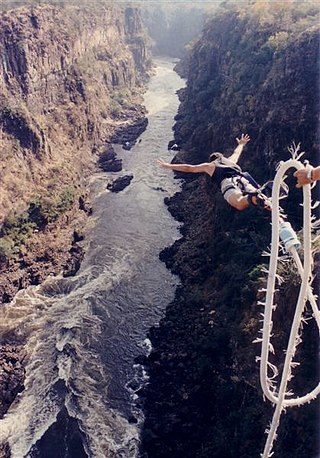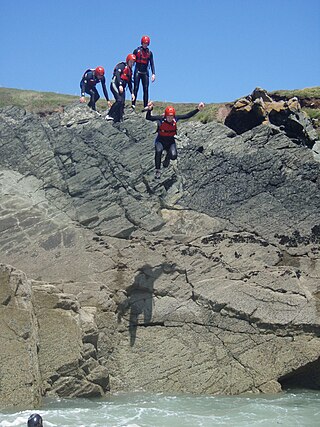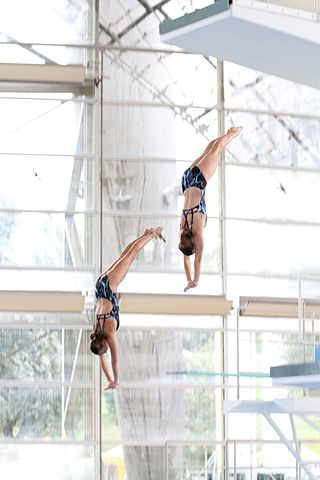
Devon is a ceremonial county in South West England. It is bordered by the Bristol Channel to the north, Somerset and Dorset to the east, the English Channel to the south, and Cornwall to the west. The city of Plymouth is the largest settlement, and the city of Exeter is the county town.

Plymouth is a port city and unitary authority in Devon, South West England. It is located on Devon's south coast between the rivers Plym and Tamar, about 36 miles (58 km) southwest of Exeter and 193 miles (311 km) southwest of London. It is the most populous city south of London.

Plymouth Hoe, referred to locally as the Hoe, is a large south-facing open public space in the English coastal city of Plymouth. The Hoe is adjacent to and above the low limestone cliffs that form the seafront and it commands views of Plymouth Sound, Drake's Island, and across the Hamoaze to Mount Edgcumbe in Cornwall. The name derives from the Anglo-Saxon word hoh, a sloping ridge shaped like an inverted foot and heel.

Bungee jumping, also spelled bungy jumping, is an activity that involves a person jumping from a great height while connected to a large elastic cord. The launching pad is usually erected on a tall structure such as a building or crane, a bridge across a deep ravine, or on a natural geographic feature such as a cliff. It is also possible to jump from a type of aircraft that has the ability to hover above the ground, such as a hot-air-balloon or helicopter. The thrill comes from the free-falling and the rebound. When the person jumps, the cord stretches and the jumper flies upwards again as the cord recoils, and continues to oscillate up and down until all the kinetic energy is dissipated.

Torquay is a seaside town in Devon, England, part of the unitary authority area of Torbay. It lies 18 miles (29 km) south of the county town of Exeter and 28 miles (45 km) east-north-east of Plymouth, on the north of Tor Bay, adjoining the neighbouring town of Paignton on the west of the bay and across from the fishing port of Brixham.

Hypothermia is defined as a body core temperature below 35.0 °C (95.0 °F) in humans. Symptoms depend on the temperature. In mild hypothermia, there is shivering and mental confusion. In moderate hypothermia, shivering stops and confusion increases. In severe hypothermia, there may be hallucinations and paradoxical undressing, in which a person removes their clothing, as well as an increased risk of the heart stopping.

Drowning is a type of suffocation induced by the submersion of the mouth and nose in a liquid. Most instances of fatal drowning occur alone or in situations where others present are either unaware of the victim's situation or unable to offer assistance. After successful resuscitation, drowning victims may experience breathing problems, vomiting, confusion, or unconsciousness. Occasionally, victims may not begin experiencing these symptoms until several hours after they are rescued. An incident of drowning can also cause further complications for victims due to low body temperature, aspiration of vomit, or acute respiratory distress syndrome.

Wingsuit flying is the sport of skydiving using a webbing-sleeved jumpsuit called a wingsuit to add webbed area to the diver's body and generate increased lift, which allows extended air time by gliding flight rather than just free falling. The modern wingsuit, first developed in the late 1990s, uses a pair of fabric membranes stretched flat between the arms and flanks/thighs to imitate an airfoil, and often also between the legs to function as a tail and allow some aerial steering.

Coasteering is movement along the intertidal zone of a rocky coastline on foot or by swimming, without the aid of boats, surf boards or other craft.

The La Quebrada Cliff Divers are a group of professional high divers, based in Acapulco, Mexico. They perform daily shows for the public, which involve diving 30 or 41 meters from the cliffs of La Quebrada into the sea below. The depth of water in the "Gulch" can vary from 4.8 to 5.8 meters depending on the waves. The width of the channel varies from 12.8 to 14.6 meters. Timing is crucial for the divers. During the night, they often hold torches while diving. Acapulco cliff diving was regularly featured on weekend sports television programming in the United States during the 1960s and 1970s when the USA High Diving Team competed with the La Quebrada Cliff Divers annually during the Acapulco Christmas Festival. The 2002 Guinness Book of World Records lists this as "the highest regularly performed headfirst dives" in the world.

Abereiddy is a hamlet in the county of Pembrokeshire, in west Wales.

Thomas Robert Daley is a British diver and television personality. Specialising in multiple events, he is an Olympic gold medallist in the men's synchronised 10-metre platform event at the 2020 Olympics and double world champion in the FINA 10-metre platform event, winning in 2009 at the age of fifteen, and again in 2017. He is an Olympic bronze medallist in the 2012 platform event, the 2016 synchronised event, and the 2020 platform event, making him the first British diver to win four Olympic medals. Daley also competes in team events, winning the inaugural mixed team World title in 2015, and repeating the win in 2024, his fourth World title in all. He is a one-time Olympic champion, 4-time World Champion, a 2-time junior World Champion, a 5-time European champion and 4-time Commonwealth champion.

High diving is the act of diving into water from relatively great heights. High diving can be performed as an adventure sport, as a performance stunt, or competitively during sporting events.
Cold shock response is a series of neurogenic cardio-respiratory responses caused by sudden immersion in cold water.
Sport in Plymouth, Devon, England, dates back to the 19th century with its first club, Plymouth United F.C., being founded in 1886. It is the largest city in England never to have had a football team in the first tier of English football. It is home to Plymouth Argyle Football Club, who play in the Football League One at the Home Park stadium in Central Park. It is Plymouth's only professional football team, however the city used to have another team called Plymouth United F.C. dating back to 1886. The club takes its nickname from the group of English non-conformists that left Plymouth for the New World in 1620: the club crest features the Mayflower, which carried the Pilgrims to Massachusetts and the club's mascot is named Pilgrim Pete.

Outdoor recreation or outdoor activity refers to recreation done outside, most commonly in natural settings. The activities that encompass outdoor recreation vary depending on the physical environment they are being carried out in. These activities can include fishing, hunting, backpacking, walking and horseback riding — and can be completed individually or collectively. Outdoor recreation is a broad concept that encompasses a varying range of activities and landscapes.

A quarry lake, also known as a pit lake, is a lake that is formed after a quarry has been dug through a mining operation.
Seatrekking is a sport that consists in exploring the shorelines of oceans, seas, bays, lakes or rivers both above and below the water over the course of several days, without the aid of a boat or a watercraft. Seatrekking involves swimming, snorkeling, freediving and hiking, and combines all these disciplines into a distinctive form of sport and outdoor experience. Unlike coasteering, seatrekking includes overnight camping and involves trips of longer distances.
Non-freezing cold injuries (NFCI) is a class of tissue damage caused by sustained exposure to low temperature without actual freezing. There are several forms of NFCI, and the common names may refer to the circumstances in which they commonly occur or were first described, such as trench foot, which was named after its association with trench warfare. NFCI is caused by microvascular endothelial damage, stasis and vascular occlusion and is characterised by peripheral neuropathy. NFCI generally affects the hands or feet during exposure to temperatures just above freezing, often wet, and is typically found in soldiers.
The Institute of Naval Medicine is the main research centre and training facility of the Royal Navy Medical Service.

















